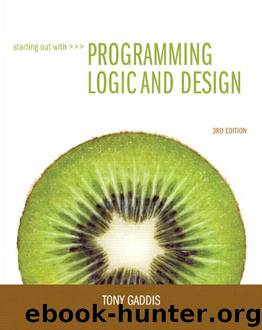Programming Logic and Design (3rd ed) by Tony Gaddis

Author:Tony Gaddis [Gaddis, Tony]
Language: eng
Format: epub
ISBN: 0132891301
Published: 2012-01-19T04:37:42+00:00
Sorting and
9 Searching Arrays
CHAPTER
T O P I C S
9.1
The Bubble Sort Algorithm
9.3
The Insertion Sort Algorithm
9.2
The Selection Sort Algorithm
9.4
The Binary Search Algorithm
9.1
The Bubble Sort Algorithm
C O N C E P T: A sorting algorithm rearranges the contents of an array so they appear in a specific order. The bubble sort is a simple sorting algorithm.
Sorting Algorithms
Many programming tasks require that the data in an array be sorted in some order.
Customer lists, for instance, are commonly sorted in alphabetical order, student grades might be sorted from highest to lowest, and product codes could be sorted so all the products of the same color are stored together. To sort the data in an array, the programmer must use an appropriate sorting algorithm. A sorting algorithm is a technique for stepping through an array and rearranging its contents in some order.
The data in an array can be sorted in either ascending or descending order. If an array is sorted in ascending order, it means the values in the array are stored from lowest to highest. If the values are sorted in descending order, they are stored from highest to lowest. This chapter discusses three sorting algorithms that you can use to sort the data in an array: the bubble sort, the selection sort, and the insertion sort. This section examines the bubble sort algorithm.
337
338
Chapter 9
Sorting and Searching Arrays
The Bubble Sort
The bubble sort is an easy way to arrange data in ascending or descending order. It is called the bubble sort algorithm because as it makes passes through and compares the elements of the array, certain values “bubble” toward the end of the array with each pass. For example, if you are using the algorithm to sort an array in ascending order, the larger values move toward the end. If you are using the algorithm to sort an array in descending order, the smaller values move toward the end. In this section you will see how the bubble sort algorithm can be used to sort an array in ascending order.
Suppose we have the array shown in Figure 9-1. Let’s see how the bubble sort can be used in arranging the array’s elements in ascending order.
Figure 9-1 An array
7
2
3
8
9
1
Element 0
Element 1
Element 2
Element 3
Element 4
Element 5
The bubble sort starts by comparing the first two elements in the array. If element 0
is greater than element 1, they are swapped. The array would then appear as shown in Figure 9-2.
Figure 9-2 Elements 0 and 1 are swapped
These elements are
swapped.
2
7
3
8
9
1
Element 0
Element 1
Element 2
Element 3
Element 4
Element 5
This method is repeated with elements 1 and 2. If element 1 is greater than element 2, they are swapped. The array would then appear as shown in Figure 9-3.
Figure 9-3 Elements 1 and 2 are swapped
These elements are
swapped.
2
3
7
8
9
1
Element 0
Element 1
Element 2
Element 3
Element 4
Element 5
Next, elements 2 and 3 are compared. In this array, these elements are already in the proper order (element 2 is less than element 3), so no values are swapped. As the cycle continues, elements 3 and 4 are compared. Once again, it is not necessary to swap the values because they are already in the proper order.
Download
This site does not store any files on its server. We only index and link to content provided by other sites. Please contact the content providers to delete copyright contents if any and email us, we'll remove relevant links or contents immediately.
Deep Learning with Python by François Chollet(12875)
Hello! Python by Anthony Briggs(10124)
The Mikado Method by Ola Ellnestam Daniel Brolund(10013)
OCA Java SE 8 Programmer I Certification Guide by Mala Gupta(9980)
Dependency Injection in .NET by Mark Seemann(9518)
Algorithms of the Intelligent Web by Haralambos Marmanis;Dmitry Babenko(8522)
Grails in Action by Glen Smith Peter Ledbrook(7882)
Test-Driven iOS Development with Swift 4 by Dominik Hauser(7853)
The Well-Grounded Java Developer by Benjamin J. Evans Martijn Verburg(7771)
Becoming a Dynamics 365 Finance and Supply Chain Solution Architect by Brent Dawson(7759)
Microservices with Go by Alexander Shuiskov(7521)
Practical Design Patterns for Java Developers by Miroslav Wengner(7439)
Test Automation Engineering Handbook by Manikandan Sambamurthy(7382)
Angular Projects - Third Edition by Aristeidis Bampakos(6805)
Secrets of the JavaScript Ninja by John Resig Bear Bibeault(6641)
The Art of Crafting User Stories by The Art of Crafting User Stories(6298)
NetSuite for Consultants - Second Edition by Peter Ries(6238)
Demystifying Cryptography with OpenSSL 3.0 by Alexei Khlebnikov(6049)
Kotlin in Action by Dmitry Jemerov(5299)
